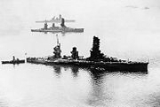
Japanese battleship Yamashiro
Encyclopedia
Yamashiro (山城) was the Imperial Japanese Navy
's second Fusō
-class battleship, and was laid down at the Yokosuka Naval Arsenal on November 20, 1913, launched on November 3, 1915, and commissioned on March 31, 1917. She was the first Japanese vessel equipped with aircraft catapults
. The ship was named after the Japanese province
where Kyoto
is located.
The Yamashiro was reconstructed from December 1930 to March 1935. The original 24 coal-fired Mijabara boilers producing 40,000 hp were replaced with six new Kanpon oil-fired boilers producing 75,000 hp. Torpedo bulges were fitted, increasing beam from 94 feet (29 m) to 100 feet (30.5 m), 6 inches. The stern was lengthened by 24 feet (7 m) to improve the fineness ratio
and restore lost speed. Deck armor was thickened to a total of 7 inches on three decks. Elevation of the main armament was increased from 30 degrees to 43 degrees. The forefunnel was removed, but converted later, the Yamashiro differed slightly from its sister ship Fusō
in the arrangement of gun turrets; by altering the "dead angle" of "C" turret from forward training to aft, deck space was left for a larger superstructure (see picture above.) Eight 5-inch (127mm)/40 heavy anti-aircraft guns were fitted, one twin mount on each side of the bridge forward, and the other pair of twin mounts high up on the tower structure aft.
 At the Battle of Surigao Strait on October 25, 1944, she came under attack and was sunk by U.S. naval forces, receiving four hits from destroyer torpedoes and numerous 14" and 16" shells from U.S. battleships. There were only around 10 survivors.
At the Battle of Surigao Strait on October 25, 1944, she came under attack and was sunk by U.S. naval forces, receiving four hits from destroyer torpedoes and numerous 14" and 16" shells from U.S. battleships. There were only around 10 survivors.
Imperial Japanese Navy
The Imperial Japanese Navy was the navy of the Empire of Japan from 1869 until 1947, when it was dissolved following Japan's constitutional renunciation of the use of force as a means of settling international disputes...
's second Fusō
Fuso class battleship
The Fusō-class battleships were two battleships of the Imperial Japanese Navy constructed during World War I. Displacing upon completion, and , the vessels of this class, were the first super-dreadnoughts of the IJN. They were completed from 1915 to 1917, both in Japanese shipyards...
-class battleship, and was laid down at the Yokosuka Naval Arsenal on November 20, 1913, launched on November 3, 1915, and commissioned on March 31, 1917. She was the first Japanese vessel equipped with aircraft catapults
Aircraft catapult
An aircraft catapult is a device used to launch aircraft from ships—in particular aircraft carriers—as a form of assisted take off. It consists of a track built into the flight deck, below which is a large piston or shuttle that is attached through the track to the nose gear of the aircraft, or in...
. The ship was named after the Japanese province
Province
A province is a territorial unit, almost always an administrative division, within a country or state.-Etymology:The English word "province" is attested since about 1330 and derives from the 13th-century Old French "province," which itself comes from the Latin word "provincia," which referred to...
where Kyoto
Kyoto
is a city in the central part of the island of Honshū, Japan. It has a population close to 1.5 million. Formerly the imperial capital of Japan, it is now the capital of Kyoto Prefecture, as well as a major part of the Osaka-Kobe-Kyoto metropolitan area.-History:...
is located.
The Yamashiro was reconstructed from December 1930 to March 1935. The original 24 coal-fired Mijabara boilers producing 40,000 hp were replaced with six new Kanpon oil-fired boilers producing 75,000 hp. Torpedo bulges were fitted, increasing beam from 94 feet (29 m) to 100 feet (30.5 m), 6 inches. The stern was lengthened by 24 feet (7 m) to improve the fineness ratio
Fineness ratio
Fineness ratio is a term used in naval architecture and aerospace engineering to describe the overall shape of a streamlined body. Specifically, it is the ratio of the length of a body to its maximum width; shapes that are "short and fat" have a low fineness ratio, those that are "long and skinny"...
and restore lost speed. Deck armor was thickened to a total of 7 inches on three decks. Elevation of the main armament was increased from 30 degrees to 43 degrees. The forefunnel was removed, but converted later, the Yamashiro differed slightly from its sister ship Fusō
Japanese battleship Fuso
The Japanese battleship Fusō , was a part of the Imperial Japanese Navy, the lead ship of the Fusō-class. She was laid down by the Kure Kaigun Koshō on 11 March 1912, launched on 28 March 1914 and completed on 18 November 1915...
in the arrangement of gun turrets; by altering the "dead angle" of "C" turret from forward training to aft, deck space was left for a larger superstructure (see picture above.) Eight 5-inch (127mm)/40 heavy anti-aircraft guns were fitted, one twin mount on each side of the bridge forward, and the other pair of twin mounts high up on the tower structure aft.

External links
- Tabular record of movement from combinedfleet.com
- Yamashiro's wreck is at coordinates 10°22′14"N 125°21′20"E
- A diary of Cedric Verdier's successful attempt in July 2006 to dive on Yamashiro. *.pdf edition here

